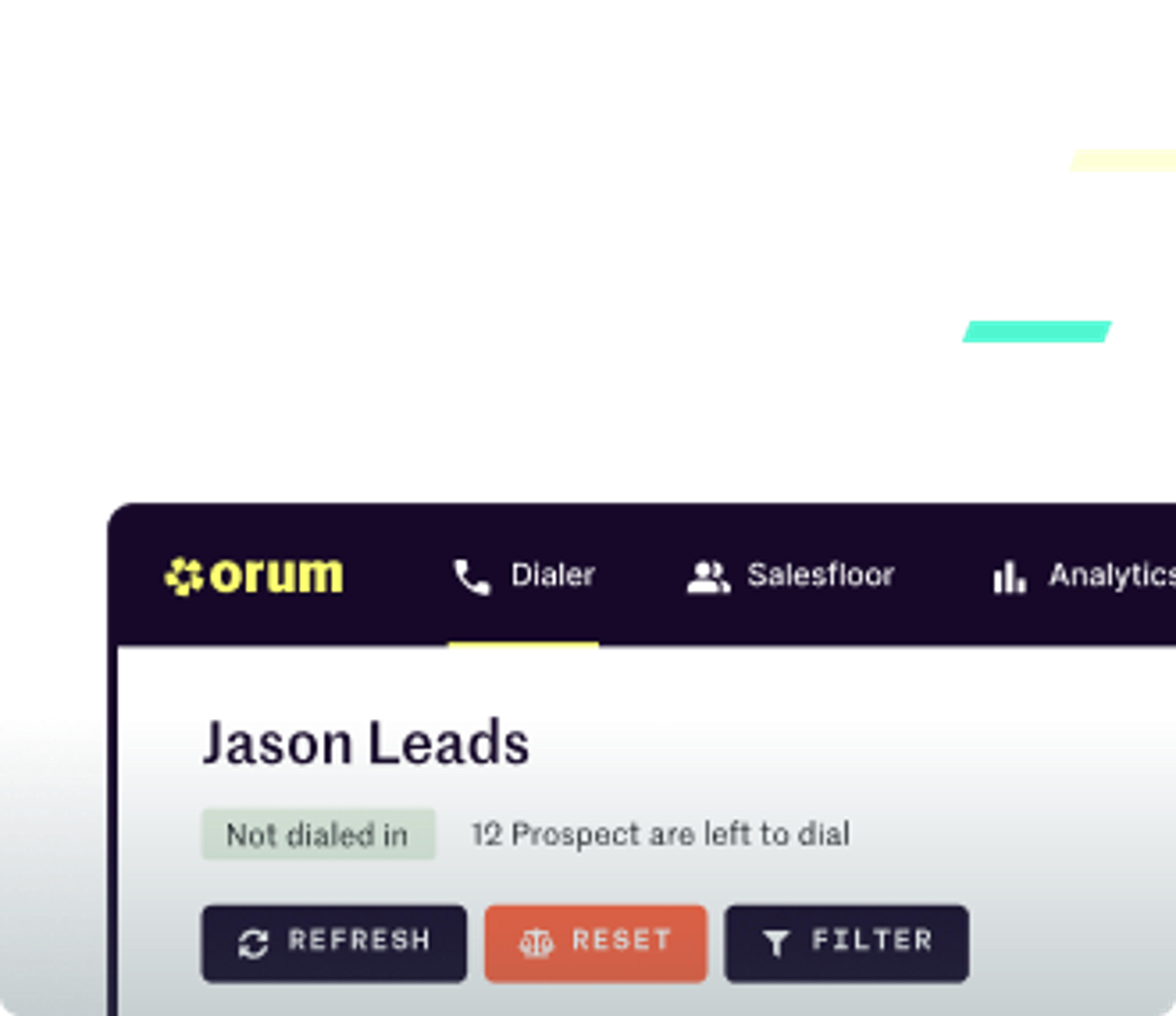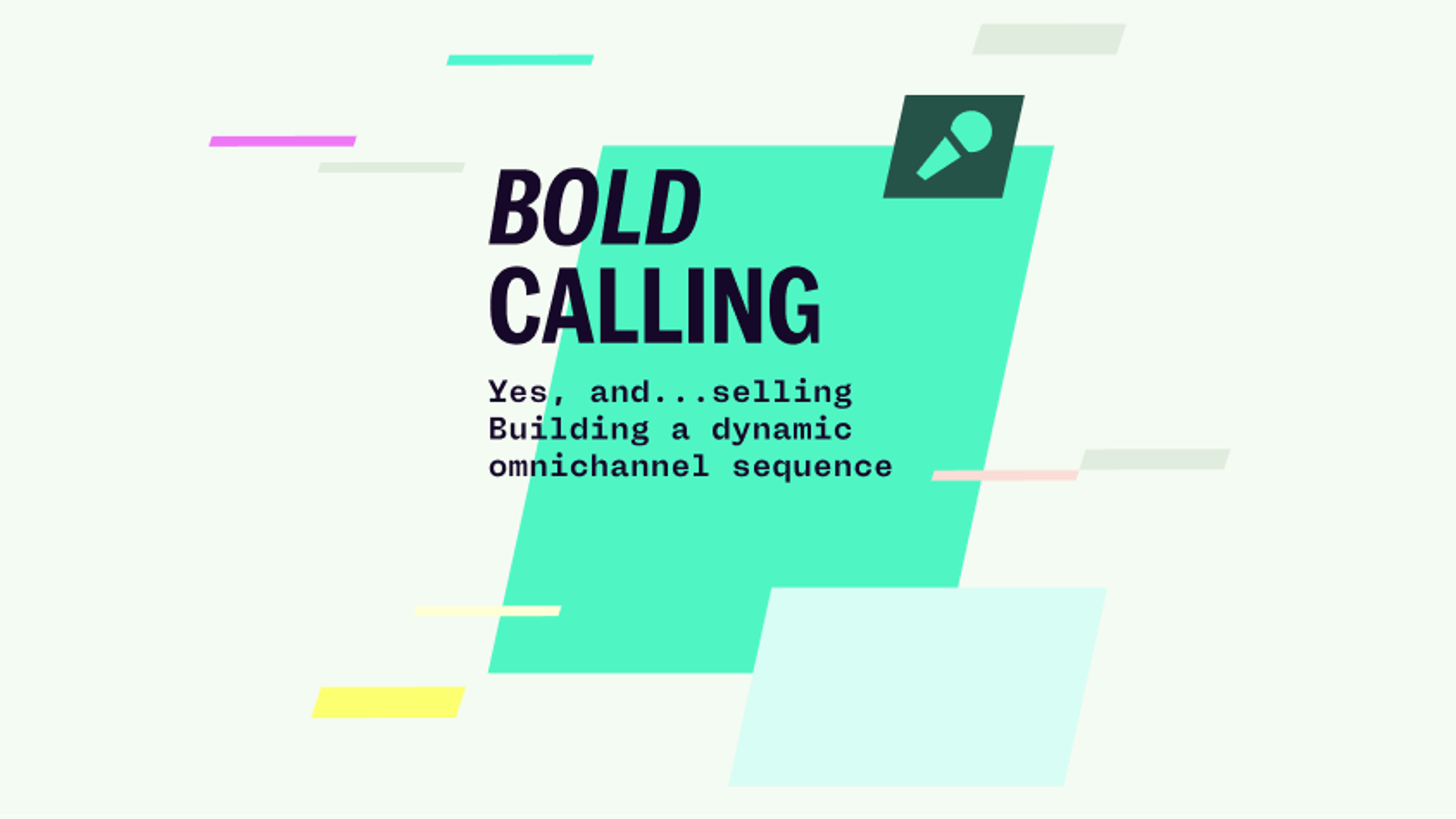Bringing the Buzz Back to the Sales Floor


When the sales reps at Orum engage with potential customers, we often get a very common reaction:
Tacit in this remark is the idea that your sales development team should be using the phone as a primary tool, but it just doesn’t seem to materialize in most organizations. I’ve heard various explanations for this:
- This is a different generation, millenials/gen-z are the social media generation and are just not used to engaging in live conversations like we used to "back in the day."
- Our product is very technical/strategic and its value cannot be communicated on a cold call.
- I can't hire talented people and get them to cold call; if I create call requirements the job will become miserable and my reps will quit.
I reject this reasoning, and in this article I'll lay out the cultural and tactical framework needed to bring the “buzz” back to the sales floor.
What you do is who you are
Cold call training and tactics are useless if your reps aren't motivated to cold call. While some of this can be traced back to recruiting, it's more likely caused by the cultural foundation of your sales team. In Ben Horowitz’s book, What You Do is Who You Are, Ben makes the claim that culture results from the behavioral details of leadership, for better or for worse. For example, if a sales leader says that it's never ok to lie to a customer, but then jumps on a customer call and lies about the functionality of the product, the sales team's behavior will eventually reflect the leader's behavior, rather than their directive. Culture results from the everyday actions of leadership and other respected people in the organization.
With this in mind, if you want to build a culture of cold calling, you must require the most respected leaders and sales reps in your company to initiate the culture by picking up the phone first. If you hire entry-level SDRs because picking up the phone is something “below you,” and therefore you must hire lower-value people to do it, that's exactly how your SDRs will perceive the art of cold calling. They'll resent cold calling as grunt work that's left over for them to do, a task no respected member of the organization actually does. They'll avoid it or try to get out of doing it quickly.
Our most recent AE hire at Orum, Jeremy Gomberg, who worked for me as both an SDR and AE at Rubrik, made a telling remark about cold calling culture:
Kyle was my third SDR hire at Rubrik and this was his first sales job. As a new SDR manager (fresh off the phones myself), I sat in a room with Kyle for his first fews weeks and made endless cold calls in front of him as we ramped up his abilities. By the time Jeremy started two years later I was already a senior manager, and while I was not cold calling every day at that point, the cultural impact remained.
Six years into Rubrik and ten years into my career, I still picked up the phone from time to time, just to reinforce this cultural principle. If the person in the position you want is still willing to pick up the phone and book a meeting, then new hires see this behavior as “cool” and an essential skill they must possess.
Furthermore, without picking up the phones yourself, not only will your directive lack credibility, but your training will also be viewed as theoretical, outdated, and obsolete.
Orum’s current one and only SDR, Harrison Saghi, is often praised for his cold calling skills by those who observe him (including the prospects he calls!). His motivation and skill comes from the fact that our VP of Sales, Colin Specter, still actively makes cold calls. If he wants to be a VP of Sales at Orum, he knows that this is a skill he must possess. He's simply reflecting the behavior of the people he respects.
Tools and efficacy
One of the reasons that cold calling has fallen out of vogue is that the productization of lead databases has made pickup rates alarmingly low across many industries.
This is why automation and tooling is essential for productive cold calling. There's no value in having your high-price sales reps spend their day listening to the phone ring, navigating dial by name directories, and manually dropping voicemails. Tools like Orum enable your team to make hundreds of calls in just minutes, while helping you procure your lead data and improve it over time.
Additionally, cold calling cannot happen in a vacuum. “More calls equals more conversations equals more meetings” is an outdated mantra and you need to ensure that your calling complements your sales engagement platform (Outreach/Salesloft) and that you're recording/monitoring conversations for quality (Gong/Chorus).
At Orum, we have some customers that struggle to book meetings over the phone, but their calls/voicemail activity drives their email/LinkedIn response rates significantly, which translates into a huge uptick in appointments booked.
By making an investment in tools and automation early on, you can save thousands (or millions) of dollars in lost productivity and underutilized headcount. The Orum sales team can build a custom spreadsheet for you that can help communicate this to your senior financial leadership.
Structure and training
While call scripts and objection cheat sheets are useful training aids, it's important to train new SDRs on product/sales fundamentals, as well as give them a high-level framework to understand the structure of a cold call.
People buy from people that they like and trust, and no one is going to trust your SDR if they don’t understand the value of the product you're selling. If your SDR has a college degree, they have likely learned calculus, chemistry, philosophy, and various other technical subjects to a high degree, and therefore learning your product and industry inside and out should be an aspiration that you achieve early on in training. When your rep makes a call with this level of knowledge, they're contacting your target prospect from within the industry, rather than trying to set an appointment as an outsider. Without this training, the SDR team will not have the trust, respect, and empathy they need to convince a skeptical prospect to take a meeting with you.
You should take your technical and market training far beyond what you think is needed for them to become an SDR. Their product knowledge should go well beyond surface-level marketing and rival that of your best AEs.
Cold calling framework
After you've equipped your reps with sufficient product knowledge, it's important to give them a framework to understand the flow and structure of a cold call. This gives them a set of guideposts to understand where they are in the interaction and enables them to choose the right time to escalate the conversation into a formal sales meeting.
The "hinge" is an opening statement that piques the interest of the target prospect. The important quality of a hinge is that it is a statement about them, not about you.
The hinge serves two purposes, primarily it gives your sales reps the internal excuse they need to justify making the call in the first place, and it shows the prospect you are not aimlessly calling them with no context on why your product or service can provide them value.
From here, the next component is the "bridge," which connects the hinge to the reason why it makes sense to engage in a conversation with your company’s sales team.
The goal of this opening is to get the prospect to start talking, so you can enter the "needs discovery" portion of the conversation.
Needs discovery is the segment of a cold calling where the prospect should be doing 80% of the talking. You achieve this by asking thoughtful, open-ended questions from a place of curiosity and deep interest.
The goal of needs discovery is to get the prospect out of the mode where they're trying to get off the phone, and into a mode of conversation where they take pleasure in talking about themselves (and their achievements) and ultimately uncovering pain points/goals that your solution aligns with.
From here, the prospect will likely start asking questions about your product as it relates to them, leading to a series of objection handling that your SDR must overcome. A great framework for objection handling is empathy-response-check (ERC).
Empathy: Repeat the objection back to them in your own words, showing that their concern is valid and that you actually listened. This is opposed to saying “I understand, but…”
Response: Assuage the concern within the objection through real-life example and reason.
Check: Ask a strategic open-ended question that leads the conversation in a positive direction, and avoid becoming a repeated objection punching bag.
The empathy phase is the most commonly skipped portion of the objection handle since it goes against our natural instinct to defend the product or cause we believe in deeply. Skipping the empathy phase will give the prospect the impression that you're not really listening and will cause them to lose trust and get defensive. A good cue when receiving an objection is to pause before answering, not just to indicate that you're listening, but to actually internalize why the prospect may be worried about the issue in the first place.
After clearing some objections and aligning the value of your product to the prospect's needs discovery, it is time to "close" for a formal sales meeting.
Some triggers that tell you it is time to ask for the meeting include:
- An in-depth technical question that requires showing the product or long-form discussion.
- A mention that there may be other people at the company that should look into this.
- A blatant expression of interest: “That's actually really cool.”
Understanding the background of the corresponding AE/SE can help make setting the meeting more like a high-value, personal introduction rather than a gawky escalation into the sales funnel.
Conclusion
Every company has the potential to bring the buzz back to the sales floor by building a culture of cold calling that starts at the top.
Through the right training and instituting the right cultural example, your SDR team will internalize this process and be eager to master this daunting and most valuable skill.
By bringing cold calling into the mix, your SDR team will not just be processing marketing leads. Rather, they will be the evangelists and change agents needed to storm the competition and capture the market.
Not to mention, it's also a lot of fun! Enjoy.
Jason Dorfman is the CEO & Co-founder of Orum and has spent 10+ years in startups, sales, and sales development. Previously, he was the first sales hire at Rubrik, where he built their WW inside sales and corporate sales teams, helping take Rubrik from 0 to $600M run rate in less than 6 years.





